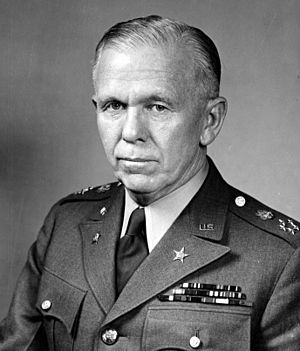George C. Marshall Foundation facts for kids

The George C. Marshall Foundation is a special place in Lexington, Virginia, USA. It was created by President Harry S. Truman to keep alive the memory and work of General George C. Marshall. He was a very important leader in the US Army, serving as its chief of staff. He also worked as the Secretary of State and Secretary of Defense for the country. General Marshall even won the Nobel Peace Prize in 1953 for something called the Marshall Plan. This plan helped rebuild Europe after World War II. The Foundation collects and protects his important papers and belongings.
About the Marshall Foundation
The George C. Marshall Foundation is found on the campus of the Virginia Military Institute. It has a library, a place for old documents (called an archive), and offices. The Foundation officially opened on May 23, 1964. A big ceremony was held with many soldiers and important leaders present. Presidents Lyndon B. Johnson and Dwight D. Eisenhower both spoke at this event. General Omar Bradley was the first president of the Foundation. Important people like Robert A. Lovett and Dr. Forrest C. Pogue were part of its first board of directors.
Marshall Museum and Research Library
The Marshall Museum used to show exhibits about General Marshall's life and work. These displays were in the main hall and two other rooms. One room focused on his time in the military. The other room showed his achievements after World War II.
The Foundation had plans to update the museum in August 2019. However, these plans did not happen. The museum then closed its doors in January 2021. The Foundation kept a small collection of items. Most of the other artifacts were sent to different museums for people to see.
The Marshall Research Library is a special part of the Foundation. It holds many historical records about the United States military and its foreign relations. These records cover the time from about 1900 until Marshall's death in 1959. The library has more than 23,000 handwritten documents. It also contains two million other documents, many from the National Archives and Records Administration. You can find hundreds of maps and thousands of photographs there too. The library also has 700 posters from countries involved in both World Wars. Plus, it has films and over 250 recorded interviews with people who knew Marshall.


